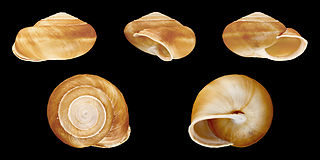

The non-marine molluscs of the Canary Islands are a part of the molluscan fauna of the Canary Islands.
Contents
A number of species of non-marine molluscs are found in the wild in Canary Islands.


The non-marine molluscs of the Canary Islands are a part of the molluscan fauna of the Canary Islands.
A number of species of non-marine molluscs are found in the wild in Canary Islands.

Lists of molluscs of surrounding countries:

The Canary Islands, also known informally as the Canaries, are a Spanish autonomous community and archipelago in Macaronesia in the Atlantic Ocean. At their closest point to the African mainland, they are 100 kilometres west of Morocco. They are the southernmost of the autonomous communities of Spain. The islands have a population of 2.2 million people and are the most populous special territory of the European Union.

A cabildo insular is the government and administration institution of each of the seven major islands in the Canary Islands archipelago: Tenerife, Fuerteventura, Gran Canaria, Lanzarote, La Palma, La Gomera and El Hierro. The island of La Graciosa falls under the jurisdiction of the cabildo of Lanzarote.
Navegacion y Servicios Aéreos Canarios, better known by its initialism NAYSA, was a regional airline based in Las Palmas, Gran Canaria, Spain. It operated scheduled and charter flights, as well as cargo flights, air taxis, air ambulance flights and crew transfers. Its main base was Gran Canaria International Airport.
The Canary Islands are an archipelago, or island chain, in the Macaronesia region of the Atlantic Ocean off the coast of North Africa. They are one of 17 autonomous communities of Spain. The demographics of the Canary Islands are concentrated in the largest islands of Tenerife and Gran Canaria.

Canariella is a genus of small air-breathing land snails, terrestrial pulmonate gastropod molluscs in the family Canariellidae, the hairy snails and their allies.

Hemicycla is a genus of medium-sized air-breathing land snails, terrestrial pulmonate gastropods in the family Helicidae, the typical snails.

Napaeus is a genus of air-breathing land snails, terrestrial pulmonate gastropod mollusks in the subfamily Eninae of the family Enidae.
Tourism is an essential part of the economy of the Canary Islands, a Spanish archipelago located in the Atlantic Ocean, 100 kilometres west of Morocco. Seven main islands and six islets make up the Canary Islands. They had more than 9 million foreign incoming tourists in 2007. Tourists seeking sunshine and beaches first began to visit the Canaries in large numbers in the 1960s. The Canary Islands are a leading European tourist destination with very attractive natural and cultural resources.
As in the rest of Spain, the majority religion in the Canary Islands is the Catholic Church. The Catholic religion has been the majority since the Conquest of the Canary Islands in the fifteenth century. This religion would largely replace the Canarian aboriginal religion through the prohibition of the latter and syncretism. According to a survey conducted in 2019, Canary Islands is the fifth autonomous community in Spain with the highest percentage of people who declare themselves to be Catholics after the Region of Murcia, Extremadura, Galicia, Aragon, and Castile and León. 76.7% of the population is Catholic.
Inés Peraza de las Casas was the territorial lady of the Canary Islands, which she inherited from her father Hernán Peraza the Elder and her late brother Guillén Peraza.
The 2019 Canarian Island Cabildo elections were held on Sunday, 26 May 2019, to elect the 11th Island Cabildos of El Hierro, Fuerteventura, Gran Canaria, La Gomera, La Palma, Lanzarote and Tenerife. All 157 seats in the seven Island Cabildos were up for election.
The 2015 Canarian Island Cabildo elections were held on Sunday, 24 May 2015, to elect the 10th Island Cabildos of El Hierro, Fuerteventura, Gran Canaria, La Gomera, La Palma, Lanzarote and Tenerife. All 155 seats in the seven Island Cabildos were up for election.
The 2003 Canarian Island Cabildo elections were held on Sunday, 25 May 2003, to elect the 7th Island Cabildos of El Hierro, Fuerteventura, Gran Canaria, La Gomera, La Palma, Lanzarote and Tenerife. All 149 seats in the seven Island Cabildos were up for election.
The 1999 Canarian Island Cabildo elections were held on Sunday, 13 June 1999, to elect the 6th Island Cabildos of El Hierro, Fuerteventura, Gran Canaria, La Gomera, La Palma, Lanzarote and Tenerife. All 139 seats in the seven Island Cabildos were up for election.
The 1995 Canarian Island Cabildo elections were held on Sunday, 28 May 1995, to elect the 5th Island Cabildos of El Hierro, Fuerteventura, Gran Canaria, La Gomera, La Palma, Lanzarote and Tenerife. All 139 seats in the seven Island Cabildos were up for election.
The 1987 Canarian Island Cabildo elections were held on Wednesday, 10 June 1987, to elect the 3rd Island Cabildos of El Hierro, Fuerteventura, Gran Canaria, La Gomera, La Palma, Lanzarote and Tenerife. All 137 seats in the seven Island Cabildos were up for election.
The 1991 Canarian Island Cabildo elections were held on Sunday, 26 May 1991, to elect the 4th Island Cabildos of El Hierro, Fuerteventura, Gran Canaria, La Gomera, La Palma, Lanzarote and Tenerife. All 139 seats in the seven Island Cabildos were up for election.

The Canarian Football Federation is the football association responsible for all competitions of any form of football developed in the Canary Islands. It is integrated into the Royal Spanish Football Federation and its headquarters are located in Santa Cruz de Tenerife.
Canaridiscus is a genus of air-breathing land snails, terrestrial pulmonate gastropod molluscs in the family Discidae, the disk snails.